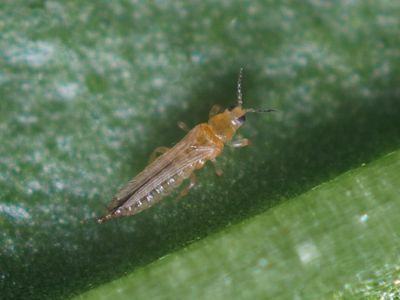THRIPS
Biology and Identification
Recognition and identification
Thrips are small, elongated insects approximately 1 to 2 mm long, with females usually being larger than males. Most species of thrips are herbivorous, although some feed on fungal spores, a few are beneficial predators, and some feed both on plant tissues and on other invertebrates (e.g. mite eggs).
The plant-feeding species rasp the surface cells of leaves (or flower petals, in some cases) and suck out the cell contents; this results in a silvery ‘flecking’ on the surface of the plant tissue that can superficially resemble the early stages of spider mite damage. Small black specks (thrips feces) may also be seen amongst the feeding scars.
Thrips feeding damage, although often relatively minor, can affect the appearance of fruits, vegetables, and some ornamental plants, and concentrated feeding on developing tissues may distort new growth, sometimes in characteristic ways (depending on species) (e.g. leaf-rolls, leaf-folds, etc.). More seriously, like aphids and whiteflies, some species of thrips can transmit plant viruses (e.g., tomato spotted wilt virus) while feeding.
Adult thrips typically have a ‘helmet-shaped’ head when viewed from above, and characteristic ‘fringed’ wings. (Thrips comprise the insect group ‘Thysanoptera’, which literally means ‘fringed wings’). The Thysanoptera as a whole is comprised of two sub-groups, the Terebrantia and Tubulifera, which differ in the number of immature stages (see below) and in the shape of the last abdominal segment (rounded or conical in the former, tubular in the latter).
When adult thrips are not flying, their wings are folded over the back of the abdomen and are hard to see. However, when opened out, each consists of a single strap- or bar-like structure (typically with few or no veins), edged with the long, fine hairs that give the group its name. Immature stages of thrips lack functional wings and are usually paler in color than adults (often translucent white/cream, yellowish, or pale tan).
The color and pattern of adult thrips varies with species, ranging from yellowish-tan to dark brown or black; some species have distinctive black and white markings on the body and/or wings. However, correct species identification usually requires examination under a dissecting microscope or a good hand-lens; in some cases, a more involved procedure involving slide-mounting and examination under a compound microscope is required.
On most indoor crops, however, only a limited number of thrips species are usually encountered. Nevertheless, some may still require careful examination to identify them correctly. Some of the commonest species include onion thrips (Thrips tabaci) (which feeds on a wide variety of crops, including cannabis) and various species of flower thrips (e.g., the western flower thrips (Frankliniella occidentalis)). A useful guide to identifying some of the main species found in protected crops can be found here.
Life-cycle
Thrips eggs—typically either an elongated cylindrical shape, or kidney-shaped—are generally either inserted into plant tissues (Terebrantia) or deposited on the surface of leaves, buds, or similar feeding sites (Tubulifera).
In herbivorous species, the newly hatched first instar larva and the following (slightly larger) second instar larva feed actively on plant issues, whereas the last two immature stages (the pre-pupa and pupal stages) are non-feeding and may be found in protected sites such as crevices or galls on the plant, or in the surface layers of the soil (note that in the Tubulifera, the third and fourth instars are both termed pre-pupae and the fifth is the pupal stage).
The duration of the life cycle (from egg to adult) depends on temperature and species, but typically takes approximately 2 to 4 weeks; several generations may therefore be completed over the course of a single crop cycle.
Adult thrips are quite mobile, and can enter greenhouses through unscreened air vents and similar openings. Where growing facilities are close to field crops or hay fields, an influx of adult thrips may occur when those crops are harvested, or when nearby weedy areas dry out. Yellow sticky traps are useful for monitoring most thrips populations (and other pests) within the crop.

Adult western flower thrips (Frankliniella occidentalis)
Copyright © 2022 Sierra Biological Inc. - All Rights Reserved.
Powered by GoDaddy
